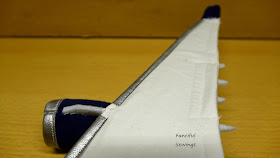Apart from the aviation, there comes also a little bit of history and geography. Continuing the line of gliders, I'm in a way honored to introduce a very special sailplane of a significant meaning in the history of Polish aviation. PWS-101, reg. marks SP-1004, was a glider that Tadeusz Góra, a polish pilot, flew in 1938 from Bezmiechowa (located in the mountain range of Bieszczady) to Soleczniki Małe (near Vilnius), covering the distance of about 360 miles (580 km). Back in the day, it was a remarkable accomplishment and the flight distance record was set, while Tadeusz Góra, as the first pilot in history, was awarded the Lilienthal Gliding Medal.
Being unable to determine how the glider of Góra actually looked like, I decided to go for the replica, SP-1005, a model of which is to be found at Bezmiechowa itself. By the way, Bezmiechowa is also where my plushie has settled :)
Wingspan measured approximately 24 inches, and the length is about 10 inches.
Facing the beautiful landscape from the top of the mountain of Bezmiechowa
The gliding field at Bezmiechowa
In the picture with the, well, 'original replica'











































